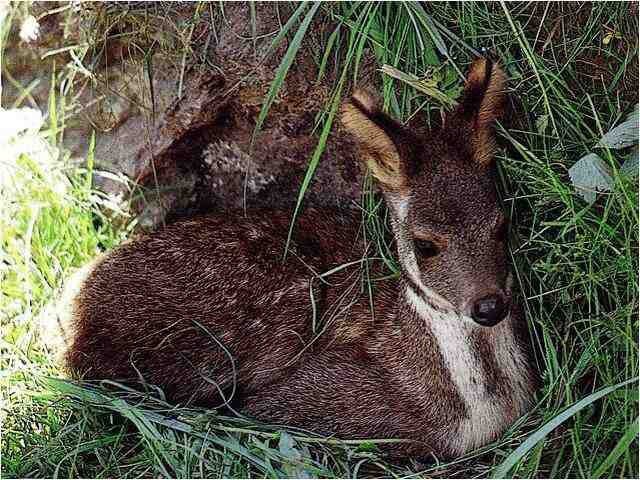Himalayan Musk Deer
IUCN
LCBasic Information
Scientific classification
- name:Himalayan Musk Deer
- Scientific Name:Tibetan Musk Deer
- Outline:Ungulata
- Family:Artiodactyla Moschidae Moschus
Vital signs
- length:86-100cm
- Weight:11-16kg
- lifetime:10-15 year
Feature
One of the six species of musk deer in China
Distribution and Habitat
Distributed in Bhutan, China, India (Sikkim), Nepal.
In China, it is distributed in the southern slope of the Himalayas in Tibet, west to the Jilong River Valley through the Boqu River Valley, and east to the Yadong River Valley.
The Himalayan musk deer inhabits mixed forests and alpine meadows between 2500 and 3900 meters above sea level. It likes to inhabit mixed forests composed of rhododendrons, hemlocks, birches, and pine trees, and alpine meadows on the upper edge of the forest line. It is rarely distributed in evergreen broad-leaved forests at low altitudes.
Appearance
The head shape is obviously wide and short, and the upper part of the ears is wide and round. The skull is strong and the length of the snout is less than half of the total length of the skull. The nasal bones are short, and their widest part is between the two lateral tips of the front end. The zygomatic arches on both sides expand outward, and the zygomatic width averages 6.72 (6.5-7.6) cm, which is larger than that of Lin Kang. The brain is well developed and the maximum width can reach 5 cm. The lacrimal bone is longer than wide, slightly triangular in shape, and has a flat surface. The front end of the frontal bone is far away from the rear end of the maxillary bone. The lacrimal bone is not connected to the nasal bone. There is a large gap between the lacrimal bone, frontal bone, nasal bone and maxillary bone. The morphology and structure of the teeth are similar to those of other musk deer species, but the length of the upper and lower dentitions is significantly longer than tha
Details
Himalayan Musk Deer, with no subspecies, is one of the six species of musk deer in China.

Himalayan Musk has a strong sense of smell. Males mark their territory by rubbing their tail glands against vegetation. This secretion also deters competitors during the breeding season. Himalayan musk deer will hiss when frightened and even scream when injured. They also have a good sense of hearing to alert them to danger. When being hunted, Himalayan musk deer will seek shelter on the mountainside. If no shelter is found, they will use their speed to run in circles to throw off the predator. However, Himalayan musk deer usually tire easily after running 200-300 meters. They can jump up to 6 meters, which is very advantageous when being chased by slower predators.
Himalayan musk deer are mainly active in the morning and evening hours, often when feeding. They are ruminants, so if threatened, they can quickly leave the feeding ground and further digest the food later without being harmed. Sometimes, Himalayan musk deer travel long distances at night to forage for food. They may travel 3-7 kilometers per night, but they always return to their territory at dawn.
Himalayan Musk Deer mate between November and January of the following year, and some females may wait until March to mate. The gestation period is 185-195 days. Female musk deer give birth in May-June, with 1-2 cubs per litter. The cubs are nursed by their mothers for about 2 months. During this time, the cubs are in hiding except for eating. At about 6 months old, Himalayan Musk Deer are weaned and able to consume food from the surrounding environment, becoming completely independent. The young deer are sexually mature at 16-24 months old. They reproduce once a year. During the mating season, male Himalayan Musk Deer become anxious, competitive, and rarely eat. While defending their territory (which includes the families of several females), males fight each other using their long canine teeth as weapons. Females show exhaustion and try to hide. During the mating season, the male musk sac is the key to attracting females. The sac emits a strong smell to induce females to hide.
The Himalayan musk deer has a narrow distribution area and a small number of people. The increase in hunting and serious habitat destruction have caused the population to be endangered. The Zhangmukouan Nature Reserve in Tibet, China, covers an area of about 68.52 hectares and plays a certain positive role in the protection of the Himalayan musk deer.
Listed in the "Red List of Endangered Species of the World Conservation Union" (IUCN) 2014 ver 3.1-Endangered (EN).
Listed in the "Red List of Chinese Species"-Endangered (EN).
Listed in the "List of Nationally Protected Wildlife in China" - Level II.
Listed in the "Convention on International Trade in Endangered Species of Wild Fauna and Flora" (CITES) - Level I.
Protect wildlife and eliminate game.
Maintaining ecological balance is everyone's responsibility!








